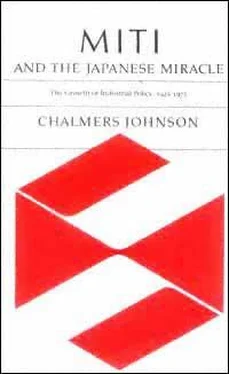Chalmers Johnson - MITI and the Japanese miracle
Здесь есть возможность читать онлайн «Chalmers Johnson - MITI and the Japanese miracle» весь текст электронной книги совершенно бесплатно (целиком полную версию без сокращений). В некоторых случаях можно слушать аудио, скачать через торрент в формате fb2 и присутствует краткое содержание. Год выпуска: 2007, Издательство: Stanford University Press, Жанр: Старинная литература, на английском языке. Описание произведения, (предисловие) а так же отзывы посетителей доступны на портале библиотеки ЛибКат.
- Название:MITI and the Japanese miracle
- Автор:
- Издательство:Stanford University Press
- Жанр:
- Год:2007
- ISBN:нет данных
- Рейтинг книги:3 / 5. Голосов: 1
-
Избранное:Добавить в избранное
- Отзывы:
-
Ваша оценка:
- 60
- 1
- 2
- 3
- 4
- 5
MITI and the Japanese miracle: краткое содержание, описание и аннотация
Предлагаем к чтению аннотацию, описание, краткое содержание или предисловие (зависит от того, что написал сам автор книги «MITI and the Japanese miracle»). Если вы не нашли необходимую информацию о книге — напишите в комментариях, мы постараемся отыскать её.
MITI and the Japanese miracle — читать онлайн бесплатно полную книгу (весь текст) целиком
Ниже представлен текст книги, разбитый по страницам. Система сохранения места последней прочитанной страницы, позволяет с удобством читать онлайн бесплатно книгу «MITI and the Japanese miracle», без необходимости каждый раз заново искать на чём Вы остановились. Поставьте закладку, и сможете в любой момент перейти на страницу, на которой закончили чтение.
Интервал:
Закладка:

title
:
MITI and the Japanese Miracle : The Growth of Industrial Policy, 1925-1975
author
:
Johnson, Chalmers A.
publisher
:
Stanford University Press
isbn10 | asin
:
print isbn13
:
9780804712064
ebook isbn13
:
9780585107622
language
:
English
subject
Japan.--Tsusho Sangyosho--History, Industrial policy--Japan--History
publication date
:
1982
lcc
:
HD3616.J33J643 1982eb
ddc
:
354.520082/06
subject
:
Japan.--Tsusho Sangyosho--History, Industrial policy--Japan--History
Page i
Miti and the Japanese Miracle
Page ii

It is only managersnot nature or laws of economics or governmentsthat make resources productive.
Peter F. Drucker
, Managing in Turbulent Times
Page iii
Miti and the Japanese Miracle
The Growth of Industrial Policy, 19251975
Chalmers Johnson

Page iv
Stanford University Press, Stanford, California
© 1982 by the Board of Trustees of the Leland Stanford Junior University
Printed in the United States of America
Cloth ISBN 0-8047-1128-3
Paper ISBN 0-8047-1206-9
Original printing 1982
Last figure below indicates year of this printing:
07 06 05 04 03 02 01 00 99 98
Page v
To the memory of
William W. Lockwood
(19061978)
who pioneered this subject
Page vii
Preface
Perhaps the oldest and most basic subject in the study of political economy is the relationship between governmental institutions and economic activity. The distinctions in this field lie at the heart of all modern political analysis: free trade versus mercantilism, socialism versus capitalism, laissez faire versus social goal setting, the public sector versus the private sectorand, ultimately, a concern with procedures (liberty) versus a concern with outcomes (equality). Japan occupies a preeminent place in this discussion as both a model and a case. Japan's postwar economic triumphthat is, the unprecedented economic growth that has made Japan the second most productive open economy that has ever existedis the best example of a state-guided market system currently available; and Japan has itself become a model, in whole or in part, for many other developing or advanced industrial systems.
The focus of this book is on the Japanese economic bureaucracy, particularly on the famous Ministry of International Trade and Industry (MITI), as the leading state actor in the economy. Although MITI was not the only important agent affecting the economy, nor was the state as a whole always predominant, I do not want to be overly modest about the importance of this subject. The particular speed, form, and consequences of Japanese economic growth are not intelligible without reference to the contributions of MITI. Collaboration between the state and big business has long been acknowledged as the defining characteristic of the Japanese economic system, but for too long the state's role in this collaboration has been either condemned as overweening or dismissed as merely supportive, without anyone's
Page viii
ever analyzing the matter. With this book I hope to contribute to such an analysis.
The history of MITI is central to the economic and political history of modern Japan. Equally important, however, the methods and achievements of the Japanese economic bureaucracy are central to the continuing debate between advocates of the communist-type command economies and advocates of the Western-type mixed market economies. The fully bureaucratized command economies misallocate resources and stifle initiative; in order to function at all, they must lock up their populations behind iron curtains or other more or less impermeable barriers. The mixed market economies struggle to find ways to intrude politically determined priorities into their market systems without catching a bad case of the "English disease" or being frustrated by the American-type legal sprawl. The Japanese, of course, do not have all the answers. But given the fact that virtually all solutions to any of the critical problems of the late twentieth centuryenergy supply, environmental protection, technological innovation, and so forthinvolve an expansion of official bureaucracy, the particular Japanese priorities and procedures are instructive. At the very least they should forewarn a foreign observer that the Japanese achievements were not won without a price being paid.
As a particular pattern of late development, the Japanese case differs from the Western market economies, the communist dictatorships of development, or the new states of the postwar world. The most significant difference is that in Japan the state's role in the economy is shared with the private sector, and both the public and private sectors have perfected means to make the market work for developmental goals. This pattern has proved to be the most successful strategy of intentional development among the historical cases. It is being repeated today in newly industrializing states of East AsiaTaiwan and South Koreaand in Singapore and other South and Southeast Asian countries. As a response to the original beneficiaries of the industrial revolution, the Japanese pattern has proved incomparably more successful than the purely state-dominated command economies of the communist world. Since the death of Mao Tse-tung even China has come to acknowledge, if not yet emulate, the achievements of the capitalist developmental state.
This study proceeds historically for reasons that are elaborated in Chapter 1. Its time frame of 1925 to 1975 is significant in that it begins with the creation of the official industrial-policy bureaucracy, covers the period in which the main issues of industrial policy were dis-
Page ix
covered and debated, and reflects the direct continuity that exists between the prewar and postwar periods in terms of personnel and organizations. As a prologue to this history, the first two chapters are devoted to an explication of the controversies surrounding industrial policy itself and Japan's bureaucratically dominated government. In a final chapter I sketch some of the broader themes raised throughout the book and attempt to abstract a model of the Japanese political economy.
In this history and analysis I attempt also to reveal some of the Japanese language of bureaucracyits concepts, euphemisms, and slogans. For readers who do not know Japanese, the parenthetical recurrence of Japanese terms in romanization may be annoying. If so, I apologize, but it must be stressed that the language of all bureaucracy is euphemistic and often opaque; students of Japan who have mastered the language will want to know precisely what I have translated, particularly since titles of laws and organizations in Japan are often rendered in English in several different ways. At the same time, for the reader who is interested in Japan but does not read Japanese, all terms, laws, book titles, and names of associations have been translated into English. Japanese personal names are given in the Japanese manner, surname followed by given name. A full list of cabinets and of ministers and vice-ministers of MITI for the period 1925 to 1975 is presented in Appendix A. Some readers may also have difficulties in distinguishing among the numerous names of Japanese people that occur in this book. Nakamura, Nagamura, Nakayama, and Nagayama are all quite distinctive names when written in Japanese, but in English they tend to blur. I do not apologize for this. Too many studies of bureaucracies and state policies read as if they were dealing with disembodied abstractions with little reference to the way things actually happened. This book is in part about working bureaucrats, and their names naturally occur often.
Читать дальшеИнтервал:
Закладка:
Похожие книги на «MITI and the Japanese miracle»
Представляем Вашему вниманию похожие книги на «MITI and the Japanese miracle» списком для выбора. Мы отобрали схожую по названию и смыслу литературу в надежде предоставить читателям больше вариантов отыскать новые, интересные, ещё непрочитанные произведения.
Обсуждение, отзывы о книге «MITI and the Japanese miracle» и просто собственные мнения читателей. Оставьте ваши комментарии, напишите, что Вы думаете о произведении, его смысле или главных героях. Укажите что конкретно понравилось, а что нет, и почему Вы так считаете.












